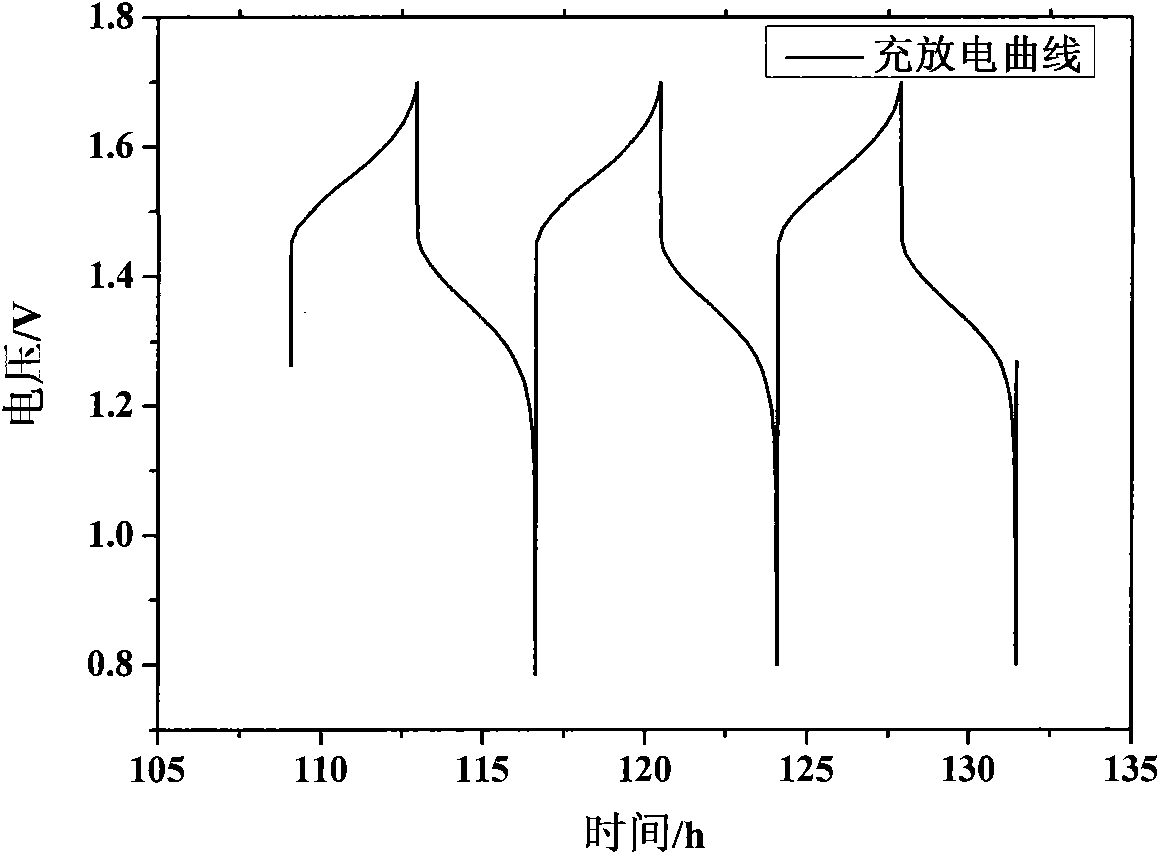Method for preparing all-vanadium ion redox flow battery electrolyte
A flow battery and electrolyte technology, applied in the direction of regenerative fuel cells, etc., can solve the problems of poor stability and low concentration of vanadium battery electrolyte, and achieve the effects of good stability, easy operation and easy availability of raw materials
- Summary
- Abstract
- Description
- Claims
- Application Information
AI Technical Summary
Problems solved by technology
Method used
Image
Examples
Embodiment 1
[0025] Dissolve 0.5 mol of methanesulfonic acid, 0.5 mol of vinylsulfonic acid, and 0.5 mol of propynylsulfonic acid in 2L of deionized water to obtain an aqueous solution containing organic acids. The organic acid is heated during the dissolution process, and the heating temperature is 80°C. Then, weigh 3 mol of vanadyl sulfate, add an aqueous solution containing an organic acid as a diluent, pour it into a volumetric flask after it is completely dissolved, and set the volume to 1000 mL to obtain a 3 mol / L vanadyl sulfate solution. Ultrasonic treatment is carried out during the dissolving process of vanadyl sulfate, and the treatment time is 60 minutes. Graphite is used as the positive and negative electrode materials, the concentration of the positive and negative electrode solutions is 3mol / L vanadyl sulfate and 1.5mol / L organic acid aqueous solution, and the charging current density is 30mA / cm 2 , the discharge current density is 30mA / cm 2 , the voltage efficiency is 85%...
Embodiment 2
[0028] Dissolve 0.5mol ethylsulfonic acid, 0.5mol allylsulfonic acid, and 0.8mol p-toluenesulfonic acid in 2L deionized water to obtain an aqueous solution containing organic acids. The organic acid is heated during the dissolution process, and the heating temperature is 60°C. Then, weigh 3 mol of vanadyl sulfate, add an aqueous solution containing an organic acid as a diluent, pour it into a volumetric flask after it is completely dissolved, and set the volume to 1000 mL to obtain a 3 mol / L vanadyl sulfate solution. Ultrasonic treatment is carried out during the dissolving process of vanadyl sulfate, and the treatment time is 30 minutes. Graphite is used as the positive and negative electrode materials, the concentrations of the positive and negative electrode solutions are 3mol / L vanadyl sulfate and 1.8mol / L organic acid aqueous solution, and the charging current density is 30mA / cm 2 , the discharge current density is 30mA / cm 2 , the voltage efficiency is 83%, the Coulombi...
Embodiment 3
[0030] Weigh 3 mol of vanadyl sulfate, add 800 mL of deionized water, heat at 80°C, and after it is completely dissolved, add: 0.5 mol of acetylene sulfonic acid, 0.5 mol of m-hydroxybenzenesulfonic acid, 1.5 mol of p-hydroxybenzenesulfonic acid, and continue stirring , after completely dissolving, add deionized water to make the volume to 1000mL to obtain 3mol / L vanadyl sulfate solution. Ultrasonic treatment is carried out during the dissolving process of vanadyl sulfate, and the treatment time is 90 minutes. Graphite is used as the positive and negative electrode materials, the concentration of the positive and negative electrode solutions is 3mol / L vanadyl sulfate and 2.5mol / L vanadyl sulfate solution, and the charging current density is 30mA / cm 2 , the discharge current density is 30mA / cm 2 , the voltage efficiency is 87%, the Coulombic efficiency is 93%, and the energy efficiency is 81%.
PUM
| Property | Measurement | Unit |
|---|---|---|
| current density | aaaaa | aaaaa |
| voltage efficiency | aaaaa | aaaaa |
| current efficiency | aaaaa | aaaaa |
Abstract
Description
Claims
Application Information
 Login to View More
Login to View More - R&D
- Intellectual Property
- Life Sciences
- Materials
- Tech Scout
- Unparalleled Data Quality
- Higher Quality Content
- 60% Fewer Hallucinations
Browse by: Latest US Patents, China's latest patents, Technical Efficacy Thesaurus, Application Domain, Technology Topic, Popular Technical Reports.
© 2025 PatSnap. All rights reserved.Legal|Privacy policy|Modern Slavery Act Transparency Statement|Sitemap|About US| Contact US: help@patsnap.com

